|
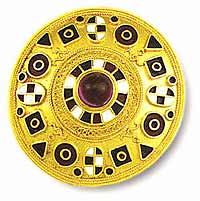
Fig. 7. Byzantine style brooch of
enamelled 18 carat gold. Similar to a piece found in Rome.
7th century AD.
LAVORO, MARIA N. POULKOURA-VOUTIRA
|

Fig. 8. Post-Byzantine
Neohellenic cross in 18 carat gold decorated with filigree and
patriarchal crown wrought from sheet gold. Chain of 22 carat
gold.
From the family collection of AGAPITOS POULKOURAS
|
|
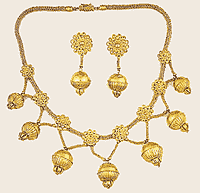
Fig. 9. Necklace with
"daisies and pomegranates" in 22 carat gold. Inspired by
Hellenistic pieces and executed in the techniques of that period.
Handmade strap chain.
From the family collection of AGAPITOS POULKOURAS
|

Fig.10. Byzantine style ring and brooch of 18
carat gold decorated with enamel and pearls
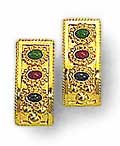 Fig.11.
& 12. Byzantine stylebracelet and earrings of 18 carat gold. Fig.11.
& 12. Byzantine stylebracelet and earrings of 18 carat gold.
Decorated with filigree and precious stones, rubies and emeralds.

|
|

Fig. 13. Bronze Age cruciform figurine
(3200-2500 BC).
Exact copy of a piece in a private collection. 18 carat gold.
CONSTANTINOS G. KOUNALAKIS
|

Fig. 14. Necklace of Byzantine inspiration,
in 18 carat gold. Cylindrical beads decorated with granulation,
lentoidand spherical spacers.
CONSTANTINOS G. KOUNALAKIS
|
|
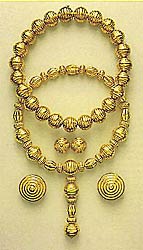
Fig. 15. Minon-Mycenaean collection 1957.
Jewellery inspired by Late Minoan and Mycanaean ornaments with beads
in various materials, techniques and shapes - spherical, biconical
or in the form of seed and fruits.
ILIAS LALAOUNIS.
|
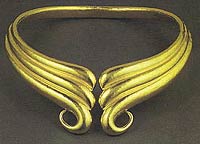
Fig. 16. 1983 ILION collection. Necklace in 18
carat gold, inspired by the Treasure of Troy.
ILIAS LALAOUNIS.
|
|
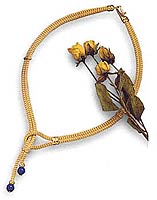
Fig. 17. Jewellery of 18
carat gold, as well as silver-gold or silver, inspired by
ancient Greek tradition (ram, Mycanaean spiral, Classical and
Hellenistic motifs etc).
COSTAS ELEFTHERIOU
|
Modern Jewellery from 1940 onwards
In the first phase of this a second period, the German Occupation, the Germans'
demand for souvenir ,jewellery kept Greek silver- and goldsmiths active.
According lo information from silver- and goldsmiths working al that lime, A.
Poulkouras, J. Roussanidis and others, this was the stimulus that set some
jewellers thinking about `tourist' jewellery and prompted them to make corre-
sponding ornaments. Mainly of silver, these included representations of the
Acropolis and various other mementoes of Greece, such as tsarouchia (traditional
pigskin shoes with pompoms.
In the sphere of silver- and goldsmithing numerous anonymous craftsmen not
only laboured with love and enthusiasm but also initiated the younger generation
into the secrets of their art, among them Nikos Lambrinidis who has taught many
the art of intaglio. Further research will surely show that a milieu of
anonymous master craftsmen with profound knowledge of silver- and goldsmithing
never ceased to exist even when it seemed that all had been forgotten. Katerina
Thanopoulou for instance created truly exquisite pieces of jewellery inspired by
Greek folk art and tradition, encouraging many to turn their attention to the
artistic wealth of Greek folk jewellery.
The creative endeavour and spirit of Greek silver- and goldsmiths are
represented by Ilias Lalaounis, whose declaration as a member of the Academie
des Bcaux Arts, of the Institut de France, not. only brought the art of Greek
silver- and goldsmithing to the fore on the international stage, hut also
imposed the art of jewellery-making as a high art, combining the traditional
bases of a workshop handicraft with the preconditions of artistic creation
(imagination, creativity, originality etc.), while at the same time utilizing
technological achievements as a valuable aid.
During this peroid the lively movement in silver- and goldsmithing, which had
already begun in the 1950s in parallel with the development of tourism,
continued apace. Tourists visiting the important archaeological museums were
impressed by the jewellery exhibited in their cases. According to Ilias
Lalaounis.
|
|


|
Greece jewellery pages Copyright ©
by Add
Information Systems. (Greece)
|

